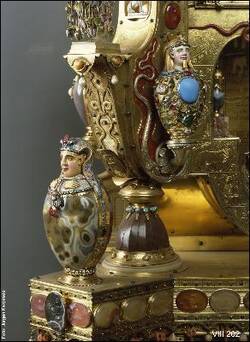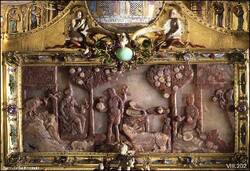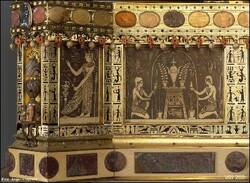It’s almost two metres high – this altar, crowned with an obelisk – and it was Johann Melchior Dinglinger’s final work. It can also be viewed as his legacy. As so often, he accepted the risk involved and worked without a commission.
Towards the end of his life, the talented jeweller was intrigued by ancient Egyptian forms and concepts. He created a work that incorporated almost all that was known in Europe at the time about that exotic culture. The result was the Apis Altar.
The focus of this final work is the Osiris myth of death and resurrection. A scene on the base shows the Egyptian god of fertility and of the Underworld on a funeral bier. It is framed by scenes of sacrifice. At the centre of the altar we see Apis, the incarnation of Osiris as a sacred bull, sailing across the Nile on a barque. He is accompanied by priests and diamond-studded crocodiles.
Our gaze is drawn upwards to a large relief made of precious stones. It comprises three panels of chalcedony, with a raised scene of the dog-headed Osiris being venerated by his wife Isis and other gods. The large round medallion above... shows the transfiguration of the divine couple, Isis and Osiris, with their child Horus.
On the entablature at the foot of the obelisk we see other gods. One of them – Serapis, on the left – is probably a portrait of the bearded sculptor Balthasar Permoser, who was one of Dinglinger’s friends. The main inspiration for this Egyptian fantasy was an engraving by Bernard de Montfaucon. The obelisk is, in fact, an exact reproduction of the Egyptian obelisk that was erected in 1588 in front of the Lateran Palace in Rome.
In its preoccupation with ancient Egyptian myths and forms, the Apis Altar is an intellectual and very personal creation of the ageing Dinglinger. In making this strange altar, he received assistance from a number of fellow-artists, and it was completed by his son. Seven years after Dinglinger’s death, August the Third acquired it for the Green Vault. The royal monogram on the base was added later.
Further Media
- Location & Dating
- Dresden, dated 1729 and 1731
- Material & Technique
- Kelheim stone, chalcedony, various types of precious stones, pearls, gold, silver, gilt, enamel, diamonds; historical table: wood, gilt
- Dimenions
- ohne Tisch: H 204,0 cm, B 102,0 cm, T 35,0 cm; H mit Tisch 286,0 cm; historischer Tisch: H 82,0 cm, B 111,0 cm, T 52,0 cm
- Museum
- Grünes Gewölbe
- Inventory number
- VIII 202


